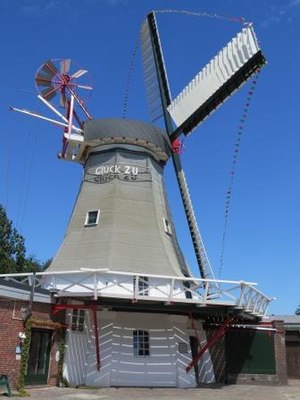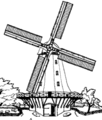Peldemühle (Wittmund)
| Peldemühle
|
||
|---|---|---|
|
Peldemühle Wittmund 2015 |
||
| Location and history | ||
|
|
||
| Coordinates | 53 ° 34 '54 " N , 7 ° 46' 28" E | |
| Location |
|
|
| Built | 1741 | |
| Status | functional technical monument | |
| technology | ||
| use | Flour mill | |
| drive | Windmill | |
| Windmill type | Gallery Dutch windmill | |
| Wing type | Louvre flaps | |
| Number of wings | 4th | |
| Tracking | Compass rose | |
| Website | www.peldemuehle-wittmund.de | |
The Peldemühle is a cultural monument in Wittmund, East Frisia . It was built in 1741 and is the oldest gallery Dutchman in Germany that is still largely functional .
history
The Müller Poppe Embcken , born around 1700 in Werdum, received permission from the East Frisian Prince Carl Edzard to build a mill in 1740 . Usually this was reserved exclusively for the authorities and was granted on a long lease ( mill right ). However, Embcken received an exemption. In return, Embcken had to pay the ruler annually wind money (recognition). The permit allowed him only the production of barley from barley . This type of grain is extremely salt-tolerant , which is why it was one of the main types of grain cultivated in East Frisia after the storm surges of the 18th century.
After receiving the approval was Embcken 1741 a mill for Pelden (peeling) of barley with residential building and barn building. At that time there were two more mills in Wittmund, the Ostiemer mill, a Wallholländer that was demolished in 1919, and the Finkenburg mill , which burned down in 1884 and was rebuilt as the Siuts mill in Auricher Straße.
Although Embcken was only allowed to peel pearl barley according to the permit, he did not adhere to it. In 1754 and 1768 there were complaints that he was grinding rye and wheat, respectively. In 1770 he handed over the Peldemühle to his son Emcke Poppen . In 1809 he built a fine grinding process and operated the Peldemühle as a pelt, grinding and rye mill. This expansion became necessary because the eating habits in East Frisia had changed. In place of barley which was potato came as a staple food and it became more and more wheat flour needed to bake.
Emcke Poppen ran the mill until 1820. He handed the mill over to a Poppe miller , who was probably his son. When patronymic naming was abolished in the Napoleonic era, many people decided to adopt their job title as a new family name. As early as 1825, the mill was taken over by Jellrich Müller , who was probably Poppe's son . The other owners were:
- Hermann Ulrich Peeken from 1828,
- Anna Catharina Meents from 1847,
- Johann Jürgens Behrends from 1848,
- Tjard Hinrich Edzards from 1897,
- Edo and Eduard Edzards from 1907,
- Heinrich Schüler from 1919,
- Hermione student from 1945,
- Erich Schüler from 1963,
- Johann you from 1974,
- Ulla and Hans-Jürgen to you from 2004,
- Johann and Helene you foundation from 2006.
In 1909 the miller's house with barn was built next to the mill. A 20 hp benzene engine installed in 1912 made the mill independent of the wind. In 1926 the mill was electrified. In the course of modernization, the mill received a compass rose in place of the old codend between 1930 and 1933 , and the blades were converted to steel rods with louvre flaps and cross stiffening. In addition, the mill was given a grinding stage for rye and wheat for the production of fine flour. In 1935 the Peldegang was expanded due to a lack of capacity, as many farmers were now able to produce their fodder meal with their own grist mills. The old millstone is embedded in the pavement in the courtyard. From 1935 the mill had a seed cleaning machine with an electric drive. In 1939 a double roller mill was added. After the Second World War , the small windmills had their last heyday. With the profits again invested in the Peldemühle. In 1949 a pneumatic conveyor system and a screw mixer were installed.
In 1952, a break in the axle head caused severe damage. In 1954 the mill cap and a wing rod had to be replaced. The spare parts came mainly from the broken down mill in Stapelmoor . In the two years in between, the mill only operated with electric power. As part of the renovation, a silo and a drying system were also built. In the 1960s, the mill became increasingly uneconomical, so that the owners at the time, the Schüler family , gave up the fine milling business in 1965. In 1970 the last miller, Erich Schüler, finally shut down the mill and offered it to the city of Wittmund as a gift. But this refused.
The building then began to fall into disrepair, which was only stopped after the auctioneer Johann Sie bought the mill in 1974. From 1976 the Wittmund Heimatverein rented the mill and set up the Wittmund Heimatmuseum in the mill. The museum was closed in 2013. In 1984 a carriage shed was built to expand the museum space. Furthermore, the old forge in Dunum was bought, demolished and rebuilt on the mill site. In the building there is a historic forge and a bakery. From 1986 a support group under the direction of Heinrich Beermann took over the maintenance and restoration. In cooperation with Johann you, he succeeded in getting the mill fully functional again by 1991. The first test run took place on December 22nd, 1990 and after 25 years grain was again cut. The work ultimately dragged on until 1996, when the Peldemühle was fully functional again. The Peldemühle has been in the Lower Saxony register of monuments since 2000.
Johann Sie died on December 3, 2004 and his children transferred the Peldemühle to the Johann und Helene Sie Foundation .
In order to be able to continue operating the mill safely after the last miller left, the Johann und Helene Foundation had the first volunteer millers trained in 2010.
The preliminary planning for the next major repair work had been in progress since 2008, when a louvre flap fell out of a wing during a storm in December 2012. The Johann and Helene You Foundation then had all the flaps dismantled in February of the following year. In 2014/15 the mill was extensively renovated. For this purpose, the wings and the canopy were dismantled on June 19th. After the mill had been completely renovated, the cap was reinstalled on November 25, 2014 and the blades on December 3, 2014. In the second construction phase, at the beginning of 2015 u. a. part of the gallery renewed. On June 22, 2015, the repair work in the Peldemühle was officially completed together with the sponsors and the craftsmen involved.
On August 4, 2015, the Friends of Peldemühle Wittmund was founded, which will support the foundation in the care and maintenance of the Peldemühle in the future.
At the beginning of the sixties an extension was built on the street side, in which Irmgard Schüler , the wife of the miller at the time, ran a grocery store. The shop closed in the early 1970s. The cultivation later served various purposes. The exhibition room of the Ostfriesischer Kunstkreis (OKK) has been in the Peldemühle annex since May 7, 2017 .
Wing language
Depending on their position in the braked state, the blades of the windmills are used to transmit signals . Four to nine wing positions are possible, some of which can only be recognized by differences in the sails or the position of the louvre flaps. For example, the break in operation can be seen from a distance and the customer does not make an effort to go to the mill. The miller also signals important family events of the miller's family (birth and death) using the joy or mourning scissors. The signals differ regionally, so that one cannot speak of a uniform signal language.
Johann and Helene You Foundation
In order to be able to continue the life's work of their parents, Ulla and Hans-Jürgen Sie founded the non-profit Johann-und-Helene-Sie-Stiftung, named after their parents, on November 6th, 2006 as a legal foundation under civil law based in Hanover . She is the owner of the mill. The purpose of the foundation is the preservation and preservation of the Peldemühle architectural and cultural monument as well as the promotion of culture, preservation of monuments, homeland and customs, in particular the sports of Boßeln and Klootschießen , as well as promotion of science, art and research in these areas, in particular the mill customer.
See also
References and individual references
- ↑ a b c Peldemühle Wittmund . Mühlenstrasse working group id Mühlenvereinigung Niedersachsen - Bremen eV. Retrieved March 2, 2014.
- ↑ The change of first and last name took place in East Friesland until the 19th century due to the patronymic naming
- ↑ a b Peldemühle . Ostfriesland Tourismus GmbH. Retrieved March 8, 2014.
- ↑ http://www.ndr.de/nachrichten/niedersachsen/oldenburg_ostfriesland/Peldemuehle-wird-saniert,muehle492.html ( Memento from December 25, 2014 in the Internet Archive ) (accessed on June 20, 2014)
- ↑ http://www.friesischer-rundfunk.de/frf/Player/playerPOP1.asp?ID=79797 ( Memento from December 7, 2014 in the Internet Archive )
- ↑ Wilok Janßen: The Peldemühle opens its doors again . In: Anzeiger für Harlingerland of September 8, 2015 (accessed on September 14, 2015).
- ↑ Ostfriesischer Kunstkreis eV in the Peldemühle (accessed on May 14, 2017)
- ↑ Johann and Helene You Foundation (accessed on May 14, 2017)







